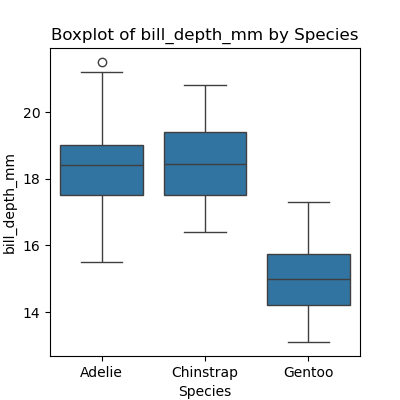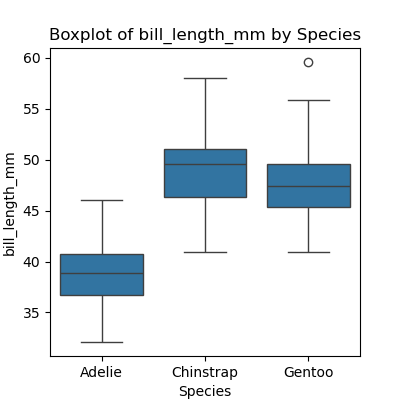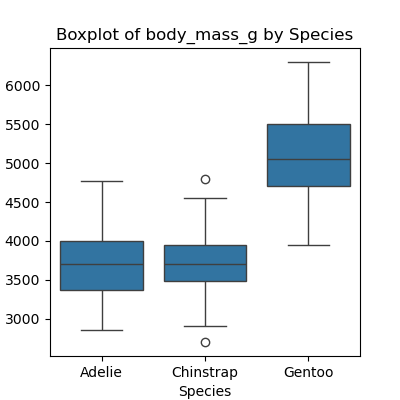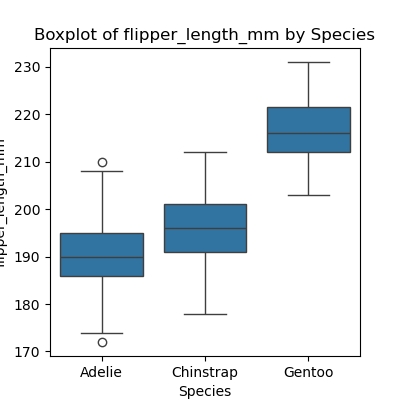Looping Over Data Sets
Last updated on 2025-02-14 | Edit this page
Overview
Questions
- How can I process many data sets with a single command?
Objectives
- Be able to read and write globbing expressions that match sets of files.
- Use glob to create lists of files.
- Write for loops to perform operations on files given their names in a list.
Use a for loop to process files given a list of their
names.
- A filename is a character string.
- And lists can contain character strings.
PYTHON
import pandas as pd
for filename in ['data/data-penguins-named.csv', 'data/data-breast-cancer.csv']:
data = pd.read_csv(filename)
print(filename, data.min())OUTPUT
data/data-penguins-named.csv species Adelie
island Biscoe
bill_length_mm 32.1
bill_depth_mm 13.1
flipper_length_mm 172.0
body_mass_g 2700.0
sex Female
dtype: object
data/data-breast-cancer.csv diagnosis 0.000000
radius_mean 6.981000
texture_mean 9.710000
perimeter_mean 43.790000
area_mean 143.500000
smoothness_mean 0.052630
compactness_mean 0.019380
concavity_mean 0.000000
concave points_mean 0.000000
symmetry_mean 0.106000
fractal_dimension_mean 0.049960
radius_se 0.111500
texture_se 0.360200
perimeter_se 0.757000
area_se 6.802000
smoothness_se 0.001713
compactness_se 0.002252
concavity_se 0.000000
concave points_se 0.000000
symmetry_se 0.007882
fractal_dimension_se 0.000895
radius_worst 7.930000
texture_worst 12.020000
perimeter_worst 50.410000
area_worst 185.200000
smoothness_worst 0.071170
compactness_worst 0.027290
concavity_worst 0.000000
concave points_worst 0.000000
symmetry_worst 0.156500
fractal_dimension_worst 0.055040
dtype: float64Use glob.glob
to find sets of files whose names match a pattern.
- In Unix, the term “globbing” means “matching a set of files with a pattern”.
- The most common patterns are:
-
*meaning “match zero or more characters” -
?meaning “match exactly one character”
-
- Python’s standard library contains the
globmodule to provide pattern matching functionality - The
globmodule contains a function also calledglobto match file patterns - E.g.,
glob.glob('*.txt')matches all files in the current directory whose names end with.txt. - Result is a (possibly empty) list of character strings.
OUTPUT
all csv files in data directory: ['data/data-penguins-named.csv', 'data/data-breast-cancer.csv']OUTPUT
all PDB files: []Use glob and for to process batches of
files.
- Helps a lot if the files are named and stored systematically and consistently so that simple patterns will find the right data.
PYTHON
for filename in glob.glob('data/data-*.csv'):
data = pd.read_csv(filename)
print(filename, data.min())OUTPUT
data/data-penguins-named.csv species Adelie
island Biscoe
bill_length_mm 32.1
bill_depth_mm 13.1
flipper_length_mm 172.0
body_mass_g 2700.0
sex Female
dtype: object
data/data-breast-cancer.csv diagnosis 0.000000
radius_mean 6.981000
texture_mean 9.710000
perimeter_mean 43.790000
area_mean 143.500000
smoothness_mean 0.052630
compactness_mean 0.019380
concavity_mean 0.000000
concave points_mean 0.000000
symmetry_mean 0.106000
fractal_dimension_mean 0.049960
radius_se 0.111500
texture_se 0.360200
perimeter_se 0.757000
area_se 6.802000
smoothness_se 0.001713
compactness_se 0.002252
concavity_se 0.000000
concave points_se 0.000000
symmetry_se 0.007882
fractal_dimension_se 0.000895
radius_worst 7.930000
texture_worst 12.020000
perimeter_worst 50.410000
area_worst 185.200000
smoothness_worst 0.071170
compactness_worst 0.027290
concavity_worst 0.000000
concave points_worst 0.000000
symmetry_worst 0.156500
fractal_dimension_worst 0.055040
dtype: float64- This includes the minimal data point in both
data-penguins-namedanddata-breast-cancerdatasets. - Use a more specific pattern in the exercises to exclude the whole data set.
Determining Matches
Which of these files is not matched by the expression
glob.glob('*as*.csv')?
gapminder_gdp_africa.csvgapminder_gdp_americas.csvgapminder_gdp_asia.csv
1 is not matched by the glob.
Minimum File Size
Modify this program so that it prints the number of records in the file that has the fewest records.
PYTHON
import glob
import pandas as pd
fewest = ____
for filename in glob.glob('data/*.csv'):
dataframe = pd.____(filename)
fewest = min(____, dataframe.shape[0])
print('smallest file has', fewest, 'records')Note that the DataFrame.shape()
method returns a tuple with the number of rows and columns of the
data frame.
PYTHON
import glob
import pandas as pd
fewest = float('Inf')
for filename in glob.glob('data/*.csv'):
dataframe = pd.read_csv(filename)
fewest = min(fewest, dataframe.shape[0])
print('smallest file has', fewest, 'records')You might have chosen to initialize the fewest variable
with a number greater than the numbers you’re dealing with, but that
could lead to trouble if you reuse the code with bigger numbers. Python
lets you use positive infinity, which will work no matter how big your
numbers are. What other special strings does the float
function recognize?
Comparing Data
Write a program that plots a boxplot of all numeric features distribution in each species. Hint: Generate a list of all the numeric columns first. Use F-string to name each plot and to save the plots at separate files.
PYTHON
import pandas as pd
import seaborn as sns
import matplotlib.pyplot as plt
numeric_columns = data_penguins.select_dtypes(include=['number']).columns.tolist()
for col in numeric_columns:
plt.figure(figsize=(4, 4))
sns.boxplot(x='species', y=col, data=data_penguins)
plt.title(f"Boxplot of {col} by Species")
plt.xlabel('Species')
plt.ylabel(col)
plt.show()



Dealing with File Paths
The pathlib
module provides useful abstractions for file and path manipulation
like returning the name of a file without the file extension. This is
very useful when looping over files and directories. In the example
below, we create a Path object and inspect its
attributes.
PYTHON
from pathlib import Path
p = Path("data/data-penguins-named.csv")
print(p.parent)
print(p.stem)
print(p.suffix)OUTPUT
data
data-penguins-named
.csvHint: Check all available attributes and methods on
the Path object with the dir() function.
- Use a
forloop to process files given a list of their names. - Use
glob.globto find sets of files whose names match a pattern. - Use
globandforto process batches of files.
